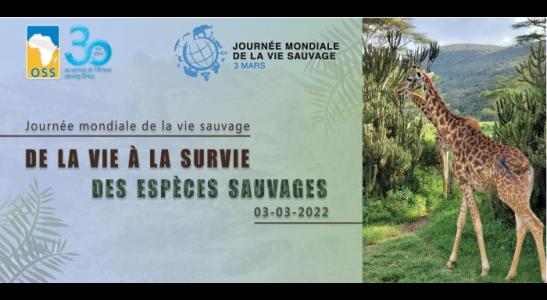Wildlife: from life to survival
World Wildlife Day

Malak CHALBI
Junior Expert
Sahara and Sahel Observatory
On this World Wildlife Day and a few days after the release of the second part of the 6th report of the Intergovernmental Panel on Climate Change (IPCC), on February 28, it would be important to take a quick look at the situation of "life" on Earth and more particularly in Africa, our continent.
Globally speaking, the latest IPCC report, went straight to the point. According to the environmental economist, Nathalie Hilmi, extreme climate episodes will be more recurrent and extensive in both hemispheres with a higher human and economic cost. The damage to biodiversity will increase and make itself more felt, in particular, through the degradation of a significant part of the forests, coral reefs and low-lying coastal wetlands. Beyond 2°C of global warming, 7 to 18% of species and 90% of corals on the African coast, will disapear. Populations and ecosystems least able to cope with disruption, are the most affected, say scientists.

Climate change, combined with the anthropogenic pressures, would have an even more disastrous impact on the African fauna and flora. Indeed, they are increasingly vulnerable and subject to various human-made threats such as overgrazing and poaching, both of which exacerbate the distortion between the level of exploitation and the availability of natural resources. Plus, a global assessment found out that hunting for bushmeat puts more than 300 species of mammals at risk. These activities represent major obstacles to achieving wildlife conservation objectives. Thousands of wild species are currently threatened with extinction and their disappearance would put habitats and ecosystems in grave danger.
To explain things better, let us have a closer look at the largest mosaic of trans-boundary protected areas in West Africa: the W-Arly-Pendjari (WAP) complex, shared between Benin, Burkina Faso and Niger. An area that has been the subject of research works on human-wildlife interactions as part of the "Integration of climate change adaptation measures in the consolidated management of the trans-boundary WAP complex" OSS project. This UNESCO World Heritage natural site and part of the international network of Biosphere Reserves of UNESCO's Man and Biosphere (MAB) program, is the last refuge for biodiversity in West Africa. It is home to most typical large mammals of the region. It has the largest population of elephants in West Africa and the only lasting population of lions in the region.
The various outcomes of the research have shown that the savannah buffalo is both the wild ungulate most impacted by transhumance, due to its close proximity to zebus in grazing areas, the most hunted and also the most poached, either for trophy purposes or for sale as bushmeat. The savannah elephant is the most poached protected wild ungulate species. These African pachyderms are, indeed, highly appreciated for their ivory tusks. They also compete with domestic animals, especially for water points. It has also been confirmed that human activities could give rise, inter alia, to carnivore attacks. This might be explained by the presence of herds in protected areas, which pushes natural prey to move and thus increases the attacks on domestic animals, on the one hand and, the decline of natural prey populations, caused by excessive hunting and poaching, leading to the incursion of predators into the riparian villages of the WAP complex, on the other hand. The lion was found to be, unanimously, the carnivore causing the most damage to domestic animals in terms of attacks. ‟The king of the jungle”, icon of power and ferocity, is however hungry and extremely threatened.
These big wild mammals, which are part of the five iconic mammals of Africa (the Big Five), are therefore subject to significant and many threats.
What could be the solution ? Would it not be pressing and necessary to take actions to protect and enhance wildlife biodiversity, for the benefit of local populations, in order to reverse the trend and improve the Livestock-Wildlife-Environment balance ?
In order to take advantage of this Day, here are some answers and some recommendations aimed at regulating the impacts of human activities, at mitigating the harm caused to wildlife and at promoting its sustainable use in the WAP complex. Let us not forget that these measures are reproducible for other areas.
The consolidation of community commitment and trans-boundary cooperation between management authorities, supported by the establishment of a network of local informants on illegal activities with effective communication tools, would be key actions to be undertaken.
Strengthening the surveillance of illegal livestock, the development of tracks for patrols and limiting transhumance in vulnerable areas are necessary actions to take. It goes the same for the mobilization of anti-poaching patrols and for the establishment of a monitoring and warning system (surveillance by drones, camera traps, etc.) in critical areas.
Developed anti-poaching equipment and adequate anti-poaching personnel should also be made available. Updating hunting quotas and having them observed, would be a big step forward for species conservation. Finally, the most important point lies in the need to highlight the economic and ecological interest of wild animals.
On the other hand, in order to reduce the human-carnivore conflict, it would be interesting to develop and strengthen protection (fences, guarding, etc.) and awareness tools (behaviour to adopt in the event of an attack, importance of protecting natural habitats and their species…), around areas and villages registering many attacks.
World Wildlife Day is, on the one hand, the ideal opportunity to highlight the priceless value of species, an integral part of life, that allows ecosystems to flourish, and, on the other hand, a wake-up call on the benefits that their preservation brings to populations, from an economic, social, scientific and ecological point of view. It is also a reminder to step up the fight against wildlife crime, stop their over-exploitation and restore their habitats and ecosystems. The principle is to marry social benefits with the requirements of effective and sustainable conservation.